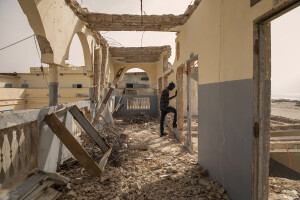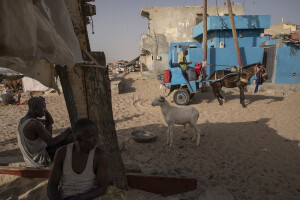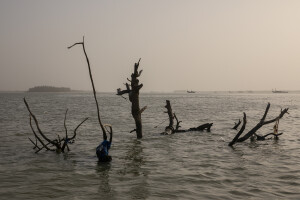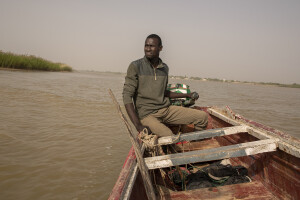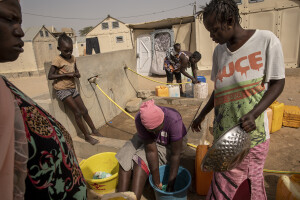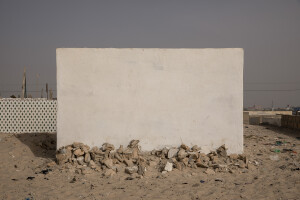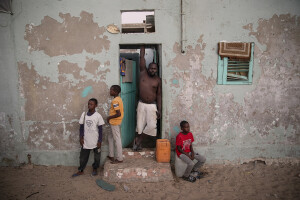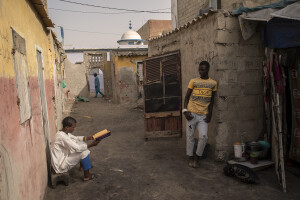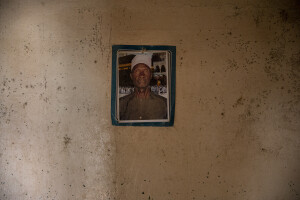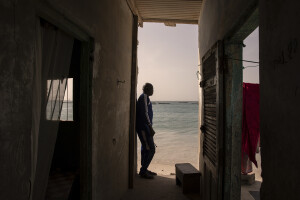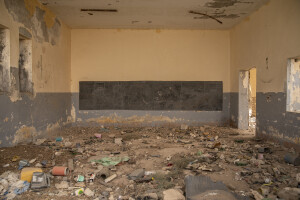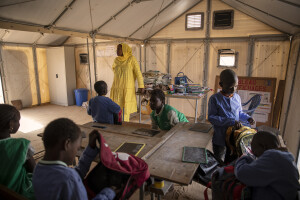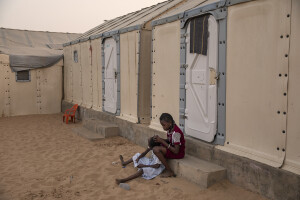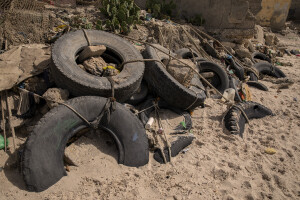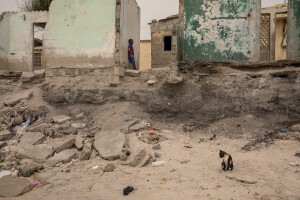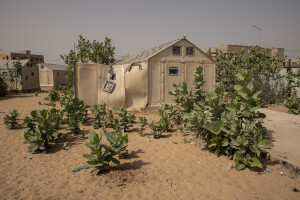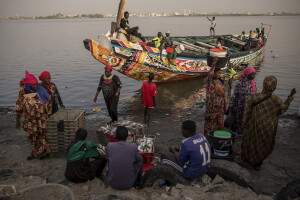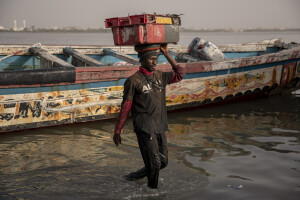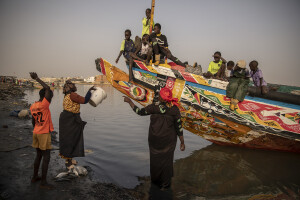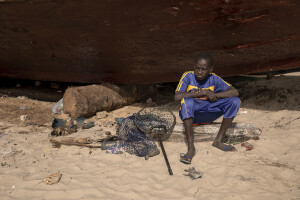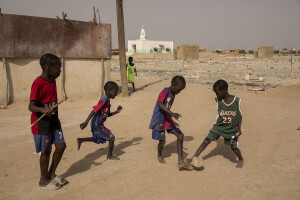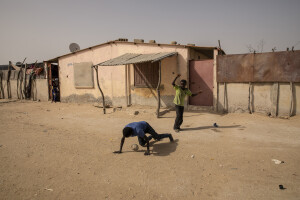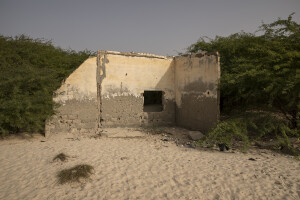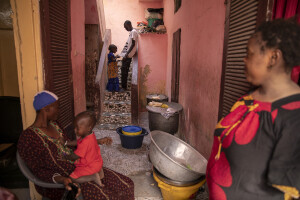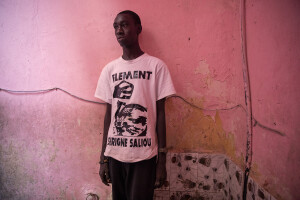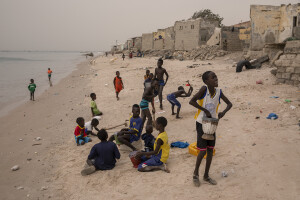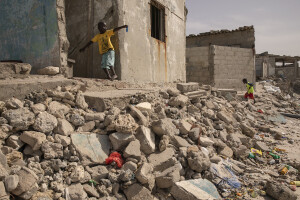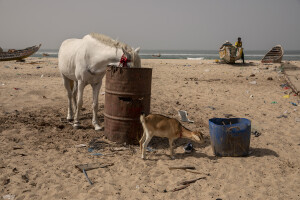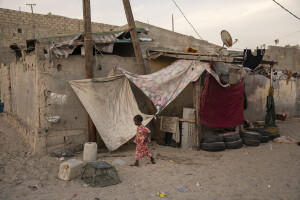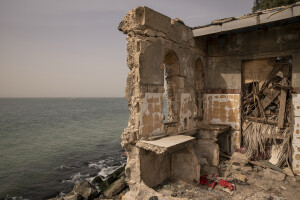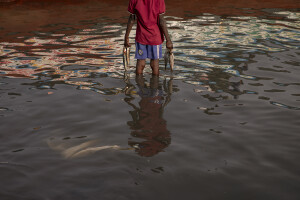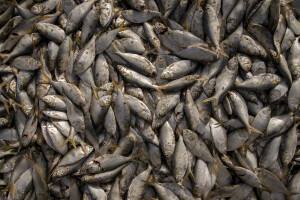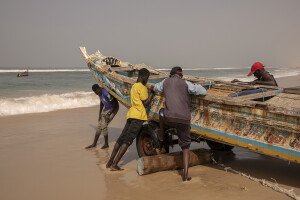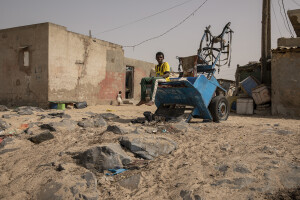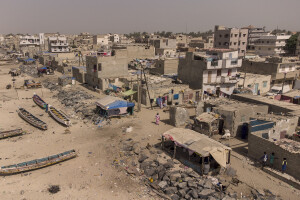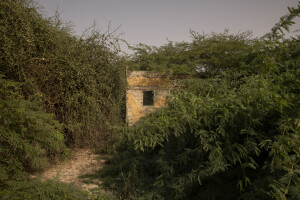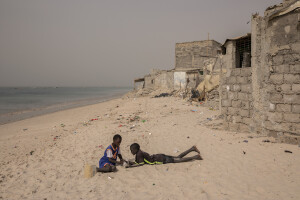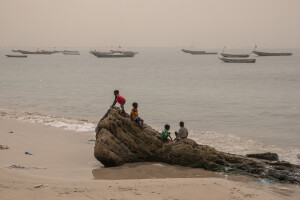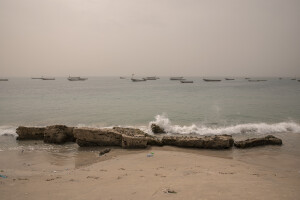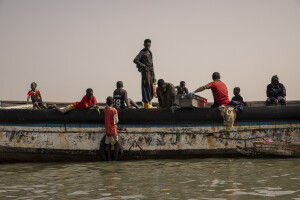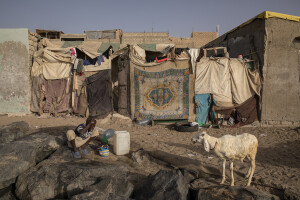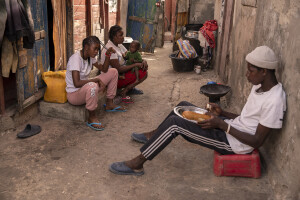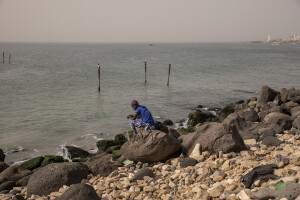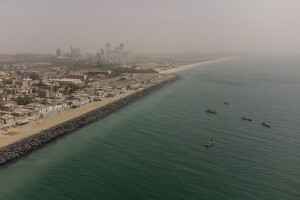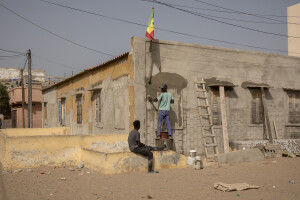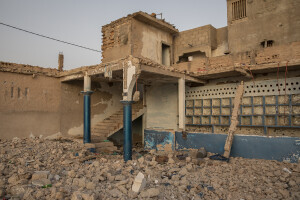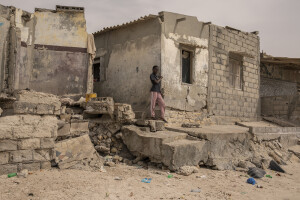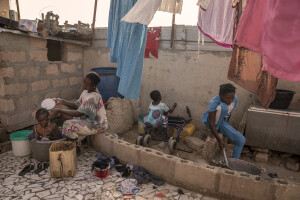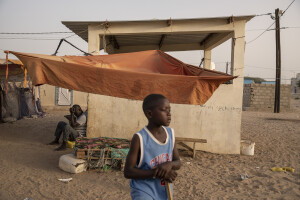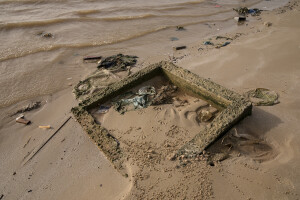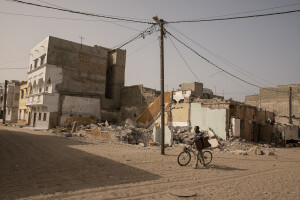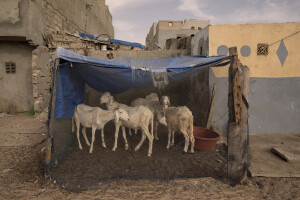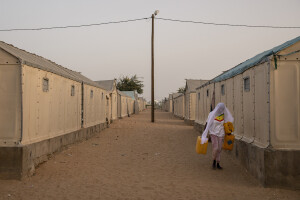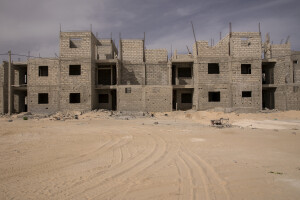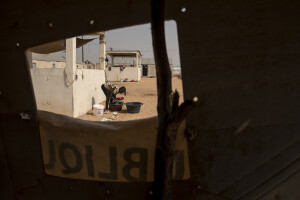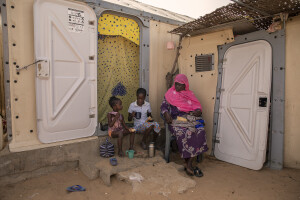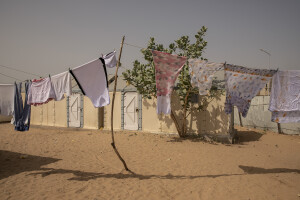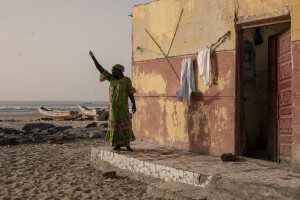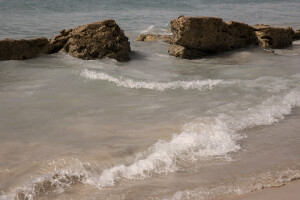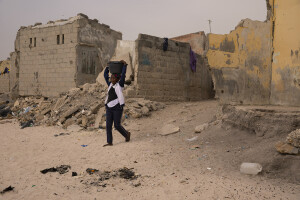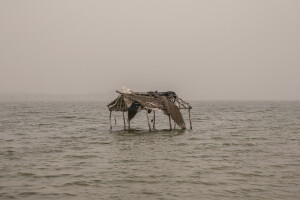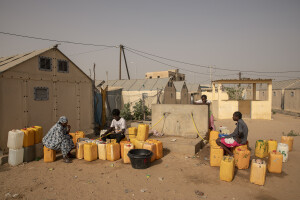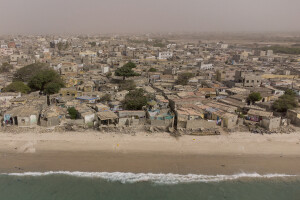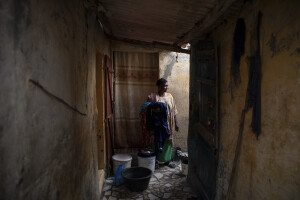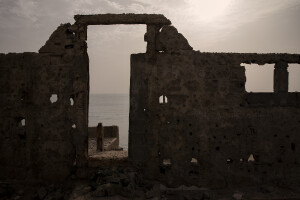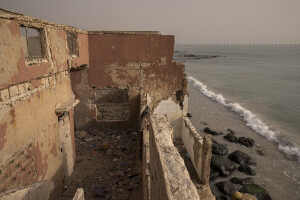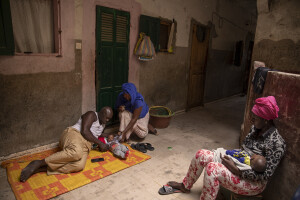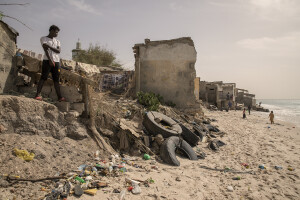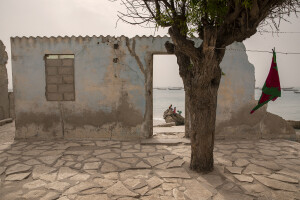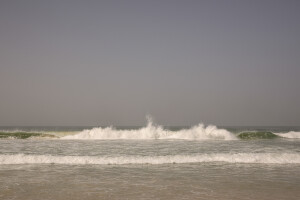The rise in sea levels generated by climate change (global warming and melting of glaciers) is threatening the coasts of Senegal, destroying one house after another and putting at risk the population, 80% of which live near the sea. The situation is particularly serious in the cities of Bargny and Saint-Louis. In the latter, more than 1500 people were transferred to the temporary camps of Djougop and Khar Yalla in the hinterland.
Although most people try not to be discouraged, every year Senegal loses around five meters of coastline and the dangers for the population are growing more and more. According to experts, sea levels on the coast of West Africa will rise by up to 4 millimeters a year, forcing thousands of people to abandon their current homes.

A boy holding a child walks near some houses heavily damaged by the sea in Bargny, Senegal on December 16, 2023. The coastal erosion began in the 1980s but worsened in the early 2000s. Storm surges have become more common and fiercer, like the passage of Hurricane Fred in the night of August 30, 2015. Bargny is currently losing three to four meters of coast each year.

A general view of the “Langue de Barbarie” in Saint-Louis, Senegal on December 14, 2023. The “Langue de Barbarie” is a thin, sandy peninsula located in western Senegal, where around 80,000 people live and is among the places most threatened by the rise in sea levels generated by climate change. The peninsula separates the Atlantic ocean from the final section of the Senegal river.

A worker is seen inside the Cheick Tourè school in Saint-Louis, Senegal on December 11, 2023. In March 2018 the school was closed following a weather warning and only a few days later part of the structure was destroyed by sea waves. Today, work is underway for the definitive demolition of the building.

Daily life scenes on the beach of the “Langue de Barbarie” in Saint-Louis, Senegal on December 14, 2023. The “Langue de Barbarie” is a thin, sandy peninsula located in western Senegal, where around 80,000 people live and is among the places most threatened by the rise in sea levels generated by climate change. The peninsula separates the Atlantic ocean from the final section of the Senegal river.

Trees submerged by water in the Doune Baba Dieye village in Saint-Louis, Senegal on December 12, 2023. Doune Baba Dieye was once a vibrant fishing community, but changing weather patterns and heavy rainfall in 2003 led to flooding inland and a rise in sea levels that have now submerged part of the village which today can only be reached by boats.

Mar Diop, 24 years old drives a pirogue headed towards the Doune Baba Dieye village in Saint-Louis, Senegal on December 12, 2023. Doune Baba Dieye was once a vibrant fishing community, but changing weather patterns and heavy rainfall in 2003 led to flooding inland and a rise in sea levels that have now submerged part of the village which today can only be reached by boats.

Women wash dishes and fill water containers inside the Djougop temporary camp for internally displaced people who lost their homes due to coastal erosion in Saint-Louis, Senegal on December 13, 2023. At Djougop temporary camp located seven miles inland people live in small tents without bathrooms and electricity. Toilets and taps for running water are shared.

A wall and a strip of stones are seen at the entrance to the cemetery to protect it from further damage from sea waves in the Guet N’dar district of Saint-Louis, Senegal on December 11, 2023. In September 2017, a four-meter wave hit the Guet N’dar district, damaging part of the cemetery.

Modou (left), Doudou (center left), Hamdy (center right) and Boubacar (right) are portrayed in front of their house facing the sea in the “Langue de Barbarie” in Saint-Louis, Senegal on December 11, 2023. The “Langue de Barbarie” is a thin, sandy peninsula located in western Senegal, where around 80,000 people live and is among the places most threatened by the rise in sea levels generated by climate change. The peninsula separates the Atlantic ocean from the final section of the Senegal river.

A boy studies the Quran in front of the Koranic school located near the sea in the “Langue de Barbarie” in Saint-Louis, Senegal on December 12, 2023. The “Langue de Barbarie” is a thin, sandy peninsula located in western Senegal, where around 80,000 people live and is among the places most threatened by the rise in sea levels generated by climate change. The peninsula separates the Atlantic ocean from the final section of the Senegal river.

A photo of Abdou Rahmane Gueye (died 2007) hangs on the wall of the house he built in the 1990s in front of the sea in Bargny, Senegal on December 16, 2023. In the past the house was larger, but the sea partially destroyed it. Two or three times a year it happens that sea water reaches inside the house. The coastal erosion began in the 1980s but worsened in the early 2000s. Storm surges have become more common and fiercer, like the passage of Hurricane Fred in the night of August 30, 2015. Bargny is currently losing three to four meters of coast each year.

Djibrilwade, 56 years old is seen inside his house facing the sea built by his father in the 1990s in Bargny, Senegal on December 16, 2023. Two or three times a year it happens that sea water reaches inside the house. The coastal erosion began in the 1980s but worsened in the early 2000s. Storm surges have become more common and fiercer, like the passage of Hurricane Fred in the night of August 30, 2015. Bargny is currently losing three to four meters of coast each year.

A classroom of the Cheick Tourè school damaged by sea in Saint-Louis, Senegal on December 11, 2023. In March 2018 the school was closed following a weather warning and only a few days later part of the structure was destroyed by sea waves. Today, work is underway for the definitive demolition of the building.

Children are seen during a french lesson inside the school of the Djougop temporary camp for internally displaced people who lost their homes due to coastal erosion in Saint-Louis, Senegal on December 13, 2023. At Djougop temporary camp located seven miles inland people live in small tents without bathrooms and electricity. Toilets and taps for running water are shared.

A little girl fixes her friend’s hair inside the Djougop temporary camp for internally displaced people who lost their homes due to coastal erosion in Saint-Louis, Senegal on December 13, 2023. At Djougop temporary camp located seven miles inland people live in small tents without bathrooms and electricity. Toilets and taps for running water are shared.

Wheels tied together and used as a barrier to stop the sea waves are seen on the beach of Bargny, Senegal on December 16, 2023. The coastal erosion began in the 1980s but worsened in the early 2000s. Storm surges have become more common and fiercer, like the passage of Hurricane Fred in the night of August 30, 2015. Bargny is currently losing three to four meters of coast each year.

A child and a cat are seen near some houses heavily damaged by the sea in Bargny, Senegal on December 19, 2023. The coastal erosion began in the 1980s but worsened in the early 2000s. Storm surges have become more common and fiercer, like the passage of Hurricane Fred in the night of August 30, 2015. Bargny is currently losing three to four meters of coast each year.

A general view of the Djougop temporary camp for internally displaced people who lost their homes due to coastal erosion in Saint-Louis, Senegal on December 13, 2023. At Djougop temporary camp located seven miles inland people live in small tents without bathrooms and electricity. Toilets and taps for running water are shared.

Women and children collect the day’s catch from a pirogue along the coast of the Senegal River in Saint-Louis, Senegal on December 11, 2023. Climate change also affects fishing, a key sector in Senegal which represents 3.2% of the country’s GDP (gross domestic product). The increase in water temperatures is having repercussions on marine ecosystems (changes in the migrations and habits of many fish species) which, in addition to the intensive fishing practiced by foreign fishing boats, is reducing the country’s fish resources. Furthermore, the advance of the sea is forcing many fishermen in Saint-Louis to leave their homes facing the sea and move inland: now to reach the sea and go fishing they have to face long and expensive journeys.

A man collects the day’s catch from a pirogue along the coast of the Senegal River in Saint-Louis, Senegal on December 11, 2023. Climate change also affects fishing, a key sector in Senegal which represents 3.2% of the country’s GDP (gross domestic product). The increase in water temperatures is having repercussions on marine ecosystems (changes in the migrations and habits of many fish species) which, in addition to the intensive fishing practiced by foreign fishing boats, is reducing the country’s fish resources. Furthermore, the advance of the sea is forcing many fishermen in Saint-Louis to leave their homes facing the sea and move inland: now to reach the sea and go fishing they have to face long and expensive journeys.

Women and children collect the day’s catch from a pirogue along the coast of the Senegal River in Saint-Louis, Senegal on December 11, 2023. Climate change also affects fishing, a key sector in Senegal which represents 3.2% of the country’s GDP (gross domestic product). The increase in water temperatures is having repercussions on marine ecosystems (changes in the migrations and habits of many fish species) which, in addition to the intensive fishing practiced by foreign fishing boats, is reducing the country’s fish resources. Furthermore, the advance of the sea is forcing many fishermen in Saint-Louis to leave their homes facing the sea and move inland: now to reach the sea and go fishing they have to face long and expensive journeys.

A young fisherman is seen on the beach of Saint-Louis, Senegal on December 14, 2023. Climate change also affects fishing, a key sector in Senegal which represents 3.2% of the country’s GDP (gross domestic product). The increase in water temperatures is having repercussions on marine ecosystems (changes in the migrations and habits of many fish species) which, in addition to the intensive fishing practiced by foreign fishing boats, is reducing the country’s fish resources. Furthermore, the advance of the sea is forcing many fishermen in Saint-Louis to leave their homes facing the sea and move inland: now to reach the sea and go fishing they have to face long and expensive journeys.

Children play football inside the Khar Yalla temporary settlement for internally displaced people who lost their homes due to coastal erosion in Saint-Louis, Senegal on December 13, 2023. Khar Yalla camp is a mix of small concrete houses and tents located in an empty field far from the city center.

Two children play football inside the Khar Yalla temporary settlement for internally displaced people who lost their homes due to coastal erosion in Saint-Louis, Senegal on December 13, 2023. Khar Yalla camp is a mix of small concrete houses and tents located in an empty field far from the city center.

The remains of a house destroyed by the sea waves in the Doune Baba Dieye village in Saint-Louis, Senegal on December 12, 2023. Doune Baba Dieye was once a vibrant fishing community, but changing weather patterns and heavy rainfall in 2003 led to flooding inland and a rise in sea levels that have now destroyed many houses and submerged part of the village which today can only be reached by boats.

Ndiagamar, 19 years old (center) plays with his niece Fatou Kiné Seck, 5 years old (center) while his sister Rokhaya, 32 years old (left) holds her son Ahmadou, 5 months old and his other sister Mame Diarra Diouf, 28 years old (right) watches them in the house where they live in Saint-Louis, Senegal on December 14, 2023. Due to the risks associated with rising sea levels, in August 2023 Ndiagamar tried to go to Spain by sea. To do this he entrusted himself to a group of traffickers and paid 400,000 senegalese francs to board a boat which was headed to Spain, but the journey stopped between Morocco and Mauritania due to bad weather conditions. The boat trip in which every year hundreds of people risk everything to leave Senegal and go to Spain is called by the local population “Barça ou barsakh”, which means “Barcelona or death”.

Ndiagamar, 19 years old is portrayed inside the house where he live in Saint-Louis, Senegal on December 14, 2023. Due to the risks associated with rising sea levels, in August 2023 Ndiagamar tried to go to Spain by sea. To do this he entrusted himself to a group of traffickers and paid 400,000 senegalese francs to board a boat which was headed to Spain, but the journey stopped between Morocco and Mauritania due to bad weather conditions. The boat trip in which every year hundreds of people risk everything to leave Senegal and go to Spain is called by the local population “Barça ou barsakh”, which means “Barcelona or death”.

Children play on the beach near houses damaged by sea waves in Bargny, Senegal on December 19, 2023. The coastal erosion began in the 1980s but worsened in the early 2000s. Storm surges have become more common and fiercer, like the passage of Hurricane Fred in the night of August 30, 2015. Bargny is currently losing three to four meters of coast each year.

Two kids are seen near some houses heavily damaged by the sea in Bargny, Senegal on December 16, 2023. The coastal erosion began in the 1980s but worsened in the early 2000s. Storm surges have become more common and fiercer, like the passage of Hurricane Fred in the night of August 30, 2015. Bargny is currently losing three to four meters of coast each year.

A horse and a goat are seen on the beach of the “Langue de Barbarie” in Saint-Louis, Senegal on December 12, 2023. The “Langue de Barbarie” is a thin, sandy peninsula located in western Senegal, where around 80,000 people live and is among the places most threatened by the rise in sea levels generated by climate change. The rise in sea levels also represents a serious danger for animals, which can be overwhelmed by the sea and die.

A girl walks near a building slightly damaged by sea waves in the “Langue de Barbarie” in Saint-Louis, Senegal on December 14, 2023. The “Langue de Barbarie” is a thin, sandy peninsula located in western Senegal, where around 80,000 people live and is among the places most threatened by the rise in sea levels generated by climate change. The peninsula separates the Atlantic ocean from the final section of the Senegal river.

The remains of a house destroyed by the sea waves in Rufisque, Senegal on December 20, 2023. The rise in sea levels generated by climate change (global warming and melting of glaciers) is threatening the coasts of Senegal, destroying one house after another and putting at risk the population, 80% of which live near the sea.

A young fisherman is seen in the water of Senegal river in Saint-Louis, Senegal on December 11, 2023. Climate change also affects fishing, a key sector in Senegal which represents 3.2% of the country’s GDP (gross domestic product). The increase in water temperatures is having repercussions on marine ecosystems (changes in the migrations and habits of many fish species) which, in addition to the intensive fishing practiced by foreign fishing boats, is reducing the country’s fish resources. Furthermore, the advance of the sea is forcing many fishermen in Saint-Louis to leave their homes facing the sea and move inland: now to reach the sea and go fishing they have to face long and expensive journeys.

The catch of the day is seen on a beach in Saint-Louis, Senegal on December 14, 2023. Climate change also affects fishing, a key sector in Senegal which represents 3.2% of the country’s GDP (gross domestic product). The increase in water temperatures is having repercussions on marine ecosystems (changes in the migrations and habits of many fish species) which, in addition to the intensive fishing practiced by foreign fishing boats, is reducing the country’s fish resources. Furthermore, the advance of the sea is forcing many fishermen in Saint-Louis to leave their homes facing the sea and move inland: now to reach the sea and go fishing they have to face long and expensive journeys.

A group of fishermen drags a pirogue into the sea before going fishing in Saint-Louis, Senegal on December 12, 2023. Climate change also affects fishing, a key sector in Senegal which represents 3.2% of the country’s GDP (gross domestic product). The increase in water temperatures is having repercussions on marine ecosystems (changes in the migrations and habits of many fish species) which, in addition to the intensive fishing practiced by foreign fishing boats, is reducing the country’s fish resources. Furthermore, the advance of the sea is forcing many fishermen in Saint-Louis to leave their homes facing the sea and move inland: now to reach the sea and go fishing they have to face long and expensive journeys.

A child sitting on a wagon near a building slightly damaged by sea waves in the “Langue de Barbarie” in Saint-Louis, Senegal on December 12, 2023. The “Langue de Barbarie” is a thin, sandy peninsula located in western Senegal, where around 80,000 people live and is among the places most threatened by the rise in sea levels generated by climate change. The peninsula separates the Atlantic ocean from the final section of the Senegal river.

A general view of the “Langue de Barbarie” in Saint-Louis, Senegal on December 14, 2023. The “Langue de Barbarie” is a thin, sandy peninsula located in western Senegal, where around 80,000 people live and is among the places most threatened by the rise in sea levels generated by climate change. The peninsula separates the Atlantic ocean from the final section of the Senegal river.

The remains of a house destroyed by the sea waves in the Doune Baba Dieye village in Saint-Louis, Senegal on December 12, 2023. Doune Baba Dieye was once a vibrant fishing community, but changing weather patterns and heavy rainfall in 2003 led to flooding inland and a rise in sea levels that have now destroyed many houses and submerged part of the village.

Two children play on the beach near houses damaged by sea waves in Bargny, Senegal on December 19, 2023. The coastal erosion began in the 1980s but worsened in the early 2000s. Storm surges have become more common and fiercer, like the passage of Hurricane Fred in the night of August 30, 2015. Bargny is currently losing three to four meters of coast each year.

Children play on an old barrier built around 1988 to stop the advance of the sea in Bargny, Senegal on December 19, 2023. The coastal erosion began in the 1980s but worsened in the early 2000s. Storm surges have become more common and fiercer, like the passage of Hurricane Fred in the night of August 30, 2015. Bargny is currently losing three to four meters of coast each year.

An old barrier built around 1988 to stop the advance of the sea in Bargny, Senegal on December 19, 2023. The coastal erosion began in the 1980s but worsened in the early 2000s. Storm surges have become more common and fiercer, like the passage of Hurricane Fred in the night of August 30, 2015. Bargny is currently losing three to four meters of coast each year.

Fishermen collect the day’s catch from a pirogue along the coast of the Senegal River in Saint-Louis, Senegal on December 14, 2023. Climate change also affects fishing, a key sector in Senegal which represents 3.2% of the country’s GDP (gross domestic product). The increase in water temperatures is having repercussions on marine ecosystems (changes in the migrations and habits of many fish species) which, in addition to the intensive fishing practiced by foreign fishing boats, is reducing the country’s fish resources. Furthermore, the advance of the sea is forcing many fishermen in Saint-Louis to leave their homes facing the sea and move inland: now to reach the sea and go fishing they have to face long and expensive journeys.

A child washes his face in front of his house facing the sea in the “Langue de Barbarie” in Saint-Louis, Senegal on December 14, 2023. The “Langue de Barbarie” is a thin, sandy peninsula located in western Senegal, where around 80,000 people live and is among the places most threatened by the rise in sea levels generated by climate change. The peninsula separates the Atlantic ocean from the final section of the Senegal river.

From left: Alima, 15 years old, Fatou, 17 years old, Fatou, 9 months old and Cherif, 20 years old are seen inside their house facing the sea in the “Langue de Barbarie” in Saint-Louis, Senegal on December 12, 2023. The “Langue de Barbarie” is a thin, sandy peninsula located in western Senegal, where around 80,000 people live and is among the places most threatened by the rise in sea levels generated by climate change. The peninsula separates the Atlantic ocean from the final section of the Senegal river.

A man sits on the barrier built to stop the advance of the sea in Rufisque, Senegal on December 20, 2023.

A general view of the barrier built to stop the advance of the sea in Rufisque, Senegal on December 20, 2023.

Two men at work to reinforce the external walls of a house and defend it from the possible arrival of sea waves in the “Langue de Barbarie” in Saint-Louis, Senegal on December 12, 2023. The “Langue de Barbarie” is a thin, sandy peninsula located in western Senegal, where around 80,000 people live and is among the places most threatened by the rise in sea levels generated by climate change. The peninsula separates the Atlantic ocean from the final section of the Senegal river.

Damage caused by sea waves to the reception of the “Chaumiere” hotel located in the “Langue de Barbarie” in Saint- Louis, Senegal on December 11, 2023. The “Langue de Barbarie” is a thin, sandy peninsula located in western Senegal, where around 80,000 people live and is among the places most threatened by the rise in sea levels generated by climate change. The peninsula separates the Atlantic ocean from the final section of the Senegal river.

A girl is seen near some houses heavily damaged by sea waves while some children play on the beach in Bargny, Senegal on December 19, 2023. The coastal erosion began in the 1980s but worsened in the early 2000s. Storm surges have become more common and fiercer, like the passage of Hurricane Fred in the night of August 30, 2015. Bargny is currently losing three to four meters of coast each year.

Bayo, 24 years old bathes her daughter, while her other two daughters play in the house where they live inside the Khar Yalla temporary settlement for internally displaced people who lost their homes due to coastal erosion in Saint-Louis, Senegal on December 13, 2023. Khar Yalla camp is a mix of small concrete houses and tents located in an empty field far from the city center.

A child and a man are seen inside the Djougop temporary camp for internally displaced people who lost their homes due to coastal erosion in Saint-Louis, Senegal on December 13, 2023. At Djougop temporary camp located seven miles inland people live in small tents without bathrooms and electricity. Toilets and taps for running water are shared.

A water purifier covered in sand and water in the Doune Baba Dieye village in Saint-Louis, Senegal on December 12, 2023. Doune Baba Dieye was once a vibrant fishing community, but changing weather patterns and heavy rainfall in 2003 led to flooding inland and a rise in sea levels that have now submerged part of the village.

A man drags a bicycle near a demolished house in the “Langue de Barbarie” in Saint-Louis, Senegal on December 12, 2023. The Senegalese government is offering money to families who leave their homes by the sea and move to Djougop temporary camp, and then proceeds to demolish those homes. The “Langue de Barbarie” is a thin, sandy peninsula located in western Senegal, where around 80,000 people live and is among the places most threatened by the rise in sea levels generated by climate change. The peninsula separates the Atlantic ocean from the final section of the Senegal river.

Sheep under a tent near the sea in the “Langue de Barbarie” in Saint-Louis, Senegal on December 15, 2023. The “Langue de Barbarie” is a thin, sandy peninsula located in western Senegal, where around 80,000 people live and is among the places most threatened by the rise in sea levels generated by climate change. The rise in sea levels also represents a serious danger for animals, which can be overwhelmed by the sea and die.

A girl with her face covered by a veil walks with water containers in her hands inside the Djougop temporary camp for internally displaced people who lost their homes due to coastal erosion in Saint-Louis, Senegal on December 13, 2023. At Djougop temporary camp located seven miles inland people live in small tents without bathrooms and electricity. Toilets and taps for running water are shared.

Houses under construction near the Djougop temporary camp for internally displaced people who lost their homes due to coastal erosion in Saint-Louis, Senegal on December 15, 2023. The homes will accommodate people living in the houses facing the sea, which are considered to be at high risk of flooding.

A girl washes clothes inside the Djougop temporary camp for internally displaced people who lost their homes due to coastal erosion in Saint-Louis, Senegal on December 13, 2023. At Djougop temporary camp located seven miles inland people live in small tents without bathrooms and electricity. Toilets and taps for running water are shared.

A mother with her two daughters eat outiside the tent where they live inside the Djougop temporary camp for internally displaced people who lost their homes due to coastal erosion in Saint-Louis, Senegal on December 13, 2023. At Djougop temporary camp located seven miles inland people live in small tents without bathrooms and electricity. Toilets and taps for running water are shared.

Clothes hanging to dry inside the Djougop temporary camp for internally displaced people who lost their homes due to coastal erosion in Saint-Louis, Senegal on December 13, 2023. At Djougop temporary camp located seven miles inland people live in small tents without bathrooms and electricity. Toilets and taps for running water are shared.

A woman is seen outiside the house where she lives in the “Langue de Barbarie” in Saint-Louis, Senegal on December 14, 2023. The Senegalese government is offering money to families who leave their homes by the sea and move to Djougop temporary camp, and then proceeds to demolish those homes. The “Langue de Barbarie” is a thin, sandy peninsula located in western Senegal, where around 80,000 people live and is among the places most threatened by the rise in sea levels generated by climate change. The peninsula separates the Atlantic ocean from the final section of the Senegal river.

An old barrier built around 1988 to stop the advance of the sea in Bargny, Senegal on December 16, 2023. The coastal erosion began in the 1980s but worsened in the early 2000s. Storm surges have become more common and fiercer, like the passage of Hurricane Fred in the night of August 30, 2015. Bargny is currently losing three to four meters of coast each year.

A woman with a basin on her head is seen near some houses heavily damaged by sea waves in Bargny, Senegal on December 19, 2023. The coastal erosion began in the 1980s but worsened in the early 2000s. Storm surges have become more common and fiercer, like the passage of Hurricane Fred in the night of August 30, 2015. Bargny is currently losing three to four meters of coast each year.

A hut, once a resting place for tourists, is submerged by the waters of Lac Rose (officially known as Lake Retba), a small naturalistic jewel located north-east of Dakar, Senegal on December 18, 2023. The environment of the lake is usually characterized by high salinity and the presence of unicellular algae called Dunaliella salina, which produce the characteristic reddish pigment. In recent months, however, torrential rains have pushed a large amount of water into the lake, tripling its usual depth and decreasing its salinity. The algae thus stopped producing colored pigments and the lake turned green. According to hydrologists, the continuous dilution with sediment-rich water could make both the salt and the microorganisms that make the lake pink disappear forever.

People fill water containers inside the Djougop temporary camp for internally displaced people who lost their homes due to coastal erosion in Saint-Louis, Senegal on December 13, 2023. At Djougop temporary camp located seven miles inland people live in small tents without bathrooms and electricity. Toilets and taps for running water are shared.

Houses heavily damaged by sea waves along the coast in Bargny, Senegal on December 19, 2023. The coastal erosion began in the 1980s but worsened in the early 2000s. Storm surges have become more common and fiercer, like the passage of Hurricane Fred in the night of August 30, 2015. Bargny is currently losing three to four meters of coast each year.

Rama, 42 years old is portrayed inside her house facing the sea in the “Langue de Barbarie” in Saint-Louis, Senegal on December 11, 2023. Rama fears that her house, already damaged by sea waves in 2019, may suffer further damage in the future. The “Langue de Barbarie” is a thin, sandy peninsula located in western Senegal, where around 80,000 people live and is among the places most threatened by the rise in sea levels generated by climate change. The peninsula separates the Atlantic ocean from the final section of the Senegal river.

A former disco bar heavily damaged by sea waves in Bargny, Senegal on December 19, 2023. The coastal erosion began in the 1980s but worsened in the early 2000s. Storm surges have become more common and fiercer, like the passage of Hurricane Fred in the night of August 30, 2015. Bargny is currently losing three to four meters of coast each year.

A former disco bar heavily damaged by sea waves in Bargny, Senegal on December 19, 2023. The coastal erosion began in the 1980s but worsened in the early 2000s. Storm surges have become more common and fiercer, like the passage of Hurricane Fred in the night of August 30, 2015. Bargny is currently losing three to four meters of coast each year.

Wouly, 3 months (left) is pampered by his grandfather Souleymane, 64 years old and his mother Arame, 38 years old while Ndeye, 22 years old (right) holds her son Khadijatou, 3 months in the house where they live in the “Langue de Barbarie” in Saint-Louis, Senegal on December 15, 2023. The Senegalese government is offering money to families who leave their homes by the sea and move to Djougop temporary camp, and then proceeds to demolish those homes. The “Langue de Barbarie” is a thin, sandy peninsula located in western Senegal, where around 80,000 people live and is among the places most threatened by the rise in sea levels generated by climate change. The peninsula separates the Atlantic ocean from the final section of the Senegal river.

A man is seen near some houses heavily damaged by sea waves while some children play on the beach in Bargny, Senegal on December 16, 2023. The coastal erosion began in the 1980s but worsened in the early 2000s. Storm surges have become more common and fiercer, like the passage of Hurricane Fred in the night of August 30, 2015. Bargny is currently losing three to four meters of coast each year.

Children are seen through a sea-facing damaged wall while they play on an old barrier built around 1988 to stop the advance of the sea in Bargny, Senegal on December 19, 2023. The coastal erosion began in the 1980s but worsened in the early 2000s. Storm surges have become more common and fiercer, like the passage of Hurricane Fred in the night of August 30, 2015. Bargny is currently losing three to four meters of coast each year.

A general view of the sea in the “Langue de Barbarie” in Saint-Louis, Senegal on December 14, 2023. The “Langue de Barbarie” is a thin, sandy peninsula located in western Senegal, where around 80,000 people live and is among the places most threatened by the rise in sea levels generated by climate change. The peninsula separates the Atlantic ocean from the final section of the Senegal river.


